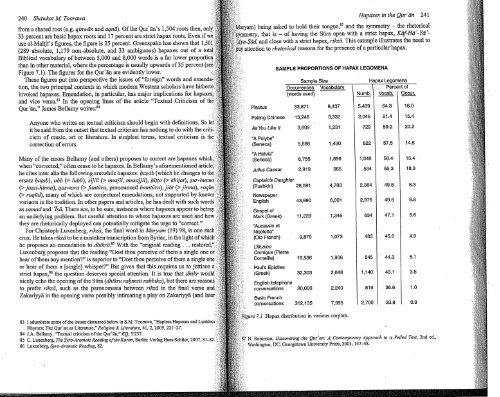reynolds-the-quran-in-its-historical-context-2
reynolds-the-quran-in-its-historical-context-2
reynolds-the-quran-in-its-historical-context-2
Create successful ePaper yourself
Turn your PDF publications into a flip-book with our unique Google optimized e-Paper software.
240 Shawkat M Toorawafrom a shared root (e.g. q<strong>in</strong>wan and aqna). Of <strong>the</strong> Qur'an's 1,504 roots <strong>the</strong>n,33 percent are basic hapax roots and 17 percent are strict hapax roots. Evenuse al-Maliji's figures, <strong>the</strong> figure is 25 percent. Greenspahn has shown that 1,50(289 absolute, 1,179 non-absolute, and 33 ambiguous) hapaxes out of a ·Biblical vocabulary of between 5,000 and 8,000 words is a far lower ,..,.,,,..m+lnnthan <strong>in</strong> o<strong>the</strong>r material, where <strong>the</strong> percentage is usually upwards of 3 5 percentFigure 7.i). The figures' for <strong>the</strong> Qur'i<strong>in</strong> are evidently lower.These figures put <strong>in</strong>to perspective <strong>the</strong> issues of "foreigu" words andtion, <strong>the</strong> two pr<strong>in</strong>cipal <strong>context</strong>s <strong>in</strong> which modem Western scholars have<strong>in</strong>voked hapaxes. Emendation, <strong>in</strong> particular, has major implications for m"~""·""··and vice versa. 83 In <strong>the</strong> open<strong>in</strong>g l<strong>in</strong>es of <strong>the</strong> article "Textual Criticism ofQur' an," James Bellamy writes: 84Anyone who writes on textual criticism should beg<strong>in</strong> with def<strong>in</strong>itions. Soit be said from <strong>the</strong> outset that textual criticism has noth<strong>in</strong>g to do with <strong>the</strong>cism of music, art or literature. In simplest terms, textual criticism is <strong>the</strong>correction of errors.Many of <strong>the</strong> errors Bellamy (and o<strong>the</strong>rs) proposes to correct are hapaxeswhen "corrected," often cease to be hapaxes. In Bellamy's aforementionedhe cites <strong>in</strong>ter alia <strong>the</strong> follow<strong>in</strong>g erstwhile hapaxes: batiab (which he changes toersatz batab ), abb (> lubb ), sijill (> musjil, musajjil), bitt a (> khitat), ~ur·-hunnn(> jazzi-h<strong>in</strong>na), qaswara (> fantara, pronounced bamtz7ra),jibt (> j<strong>in</strong>na), raqfm(> ntqz7d), many of which are conjectural emendations, not supported byvariants <strong>in</strong> <strong>the</strong> tradition. In o<strong>the</strong>r papers and articles, he has dealt with suchas tjamad and 'lsa. There are, to be sure, <strong>in</strong>stances where hapaxes appear toan underly<strong>in</strong>g problem. But careful attention to where hapaxes are used and how ·:<strong>the</strong>y are rhetorically deployed can potentially mitigate <strong>the</strong> urge to "correct." · ·For Christoph Luxenberg, rikza, <strong>the</strong> f<strong>in</strong>al word <strong>in</strong> Maryam (19) 98, is one such·crux. He takes rikza to be a mistaken transcription from, Syriac, <strong>in</strong> <strong>the</strong> light of which·.he proposes an emendation to dhikra. 85 With <strong>the</strong> "orig<strong>in</strong>al read<strong>in</strong>g ... restored,"Luxenburg proposes that <strong>the</strong> read<strong>in</strong>g "Dost thou perceive of <strong>the</strong>m a s<strong>in</strong>gle one orhear of <strong>the</strong>m any mention?" is superior to "Dost thou perceive of <strong>the</strong>m a s<strong>in</strong>gle one· •or hear of <strong>the</strong>m a [s<strong>in</strong>gle] whisper?" But given that this requires us to jettison astrict hapax, 86 <strong>the</strong> question deserves special attention. It is true that dhikrnicely echo <strong>the</strong> open<strong>in</strong>g of <strong>the</strong> Sura (dhiknt rabmati rabbika), but <strong>the</strong>re are reasonS ·to prefer rikza, such as <strong>the</strong> paronomasia between rikza <strong>in</strong> <strong>the</strong> f<strong>in</strong>al verse and .Zakariyya <strong>in</strong> <strong>the</strong> open<strong>in</strong>g verse possibly <strong>in</strong>timat<strong>in</strong>g a play on Zakariyya (and later •.83 I adumbrate some of <strong>the</strong> issues discussed below <strong>in</strong> S.M. Toorawa, "Hapless Hapaxes and Luckless .Rhymes: The Qur'an as Literature," Religion & Literature, 41, 2, 2009,221-27.84 J.A. Bellamy, "Textual criticism of <strong>the</strong> Qur'i<strong>in</strong>," EQ, 5:237.85 C. Luxenberg, The Syro-Aramaic Read<strong>in</strong>g of <strong>the</strong> Koran, Berl<strong>in</strong>: Verlag Hans Schiler, 2007, 81-82.86 Luxenberg, Syro-Aramaic Read<strong>in</strong>g, 82.Hapaxes <strong>in</strong> <strong>the</strong> Qur'an 241be<strong>in</strong>g asked to hold <strong>the</strong>ir tongue, 87 and <strong>the</strong> symmet:J:y- <strong>the</strong> rhetoricalthat is .- of hav<strong>in</strong>g <strong>the</strong> Silra open with a strict hapax, Kaj-Ha '-Ya 'and close with a strict hapax, rikza. This example illustrates <strong>the</strong> need toattention to rhetorical reasons for <strong>the</strong> presence of a particular hapax.SAMPLE PROPORTIONS OF HAPAX LEGOMENAPlautus 33,871Pek<strong>in</strong>g Ch<strong>in</strong>ese · 13,248As You Like It 3,609"A Polybe"(Seneca) 5,688"A He\via"(Seneca) 6,755Julius Caesar 2,919Capta<strong>in</strong>'s Daughter(Pushk<strong>in</strong>) 28,591NewspaperEnglish 43,990Gospel ofMark (Greek) 11,229"Aucass<strong>in</strong> etNicolette"(Old French) 9,870t:i/lusionComique (PierreCorneille) 16,586Paul's Epistles(Greek) 32,303English telephoneconversations 80,000Basic Frenchconversations 312,135Sample SizeOccurrences Vocabulary(words used)8,4373,3321,2311,4301,8569654,7836,0011,3451,0731,9062,6482,2407,9957.1 Hapax distribution <strong>in</strong> various corpora.Hapax LegomenaPercent ofNumb. Vocab. Occur.5,4392,0467298221,0465342,3842,9766344838451,1408192,70064.361.459.257.556.455.349.849.647.145.044.343.136.633.816.015.420.214.515.4N. Rob<strong>in</strong>son, Discover<strong>in</strong>g <strong>the</strong> Qur'an: A Con'temporary Approach to a Veiled Text, 2nd ed.,Wash<strong>in</strong>gton, DC: Georgetown University Press, 2003, 147-48.18.38.36.85.64.95.13.51.00.9


